To cook poultry safely, you'll need to set your oven to 375°F (190°C) and guarantee the meat reaches an internal temperature of 165°F (74°C). Insert a food thermometer into the thickest part of the thigh or breast, avoiding bones for accurate readings. You can achieve food safety at lower temperatures with longer holding times – for example, 150°F (65.6°C) for 3 minutes. Always let your poultry rest for 3-15 minutes after cooking, depending on size. While visual cues can help, they're not reliable indicators of doneness. Our detailed temperature guide will help you master the perfect poultry preparation.
Essential Temperature Safety Requirements
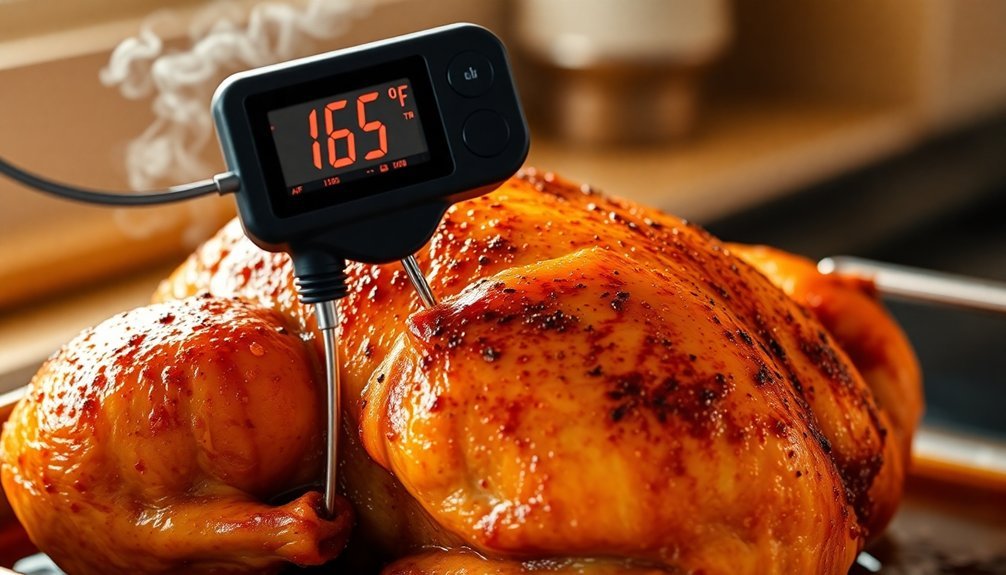
When cooking poultry safely, you'll need to follow specific temperature guidelines to eliminate harmful bacteria. Your chicken, turkey, duck, or goose must reach an internal temperature of 165°F (74°C), and this applies to all parts including ground poultry.
To check the temperature correctly, insert your meat thermometer into the thickest part of the breast and the innermost sections of thighs and wings, avoiding contact with bones.
While Health Canada suggests higher temperatures up to 185°F (85°C), the USDA confirms that 165°F (74°C) is sufficient for food safety. At least 3 minutes of resting time is required after cooking to ensure proper temperature stabilization.
You'll want to maintain consistent oven temperatures, typically 375°F (190°C) for whole birds.
Remember that high humidity during cooking helps achieve safe internal temperatures, and holding the meat at the target temperature further guarantees safety.
Proper Thermometer Placement
Knowing how to check internal temperatures is only half the battle – proper thermometer placement makes all the difference in guaranteeing your poultry is safe to eat.
When checking the thigh, insert your thermometer into the thickest part just above the drumstick, angling it down from where the knee meets the inner thigh area.
For breast temperature readings, place the probe in the thickest section, and if you're cooking stuffed poultry, don't forget to check the stuffing's center. All areas must reach 165°F (73.9°C) for safe consumption.
Remember to avoid common mistakes: don't let the probe touch bones, as they heat faster than meat, and guarantee deep insertion for accurate core readings.
To maintain meat integrity, minimize probe insertions, as multiple punctures can lead to juice loss. Today's smart meat thermometers like the ThermoPro TP972 dual probes allow for continuous monitoring without repeatedly piercing the meat.
Critical Cooking Time Calculations
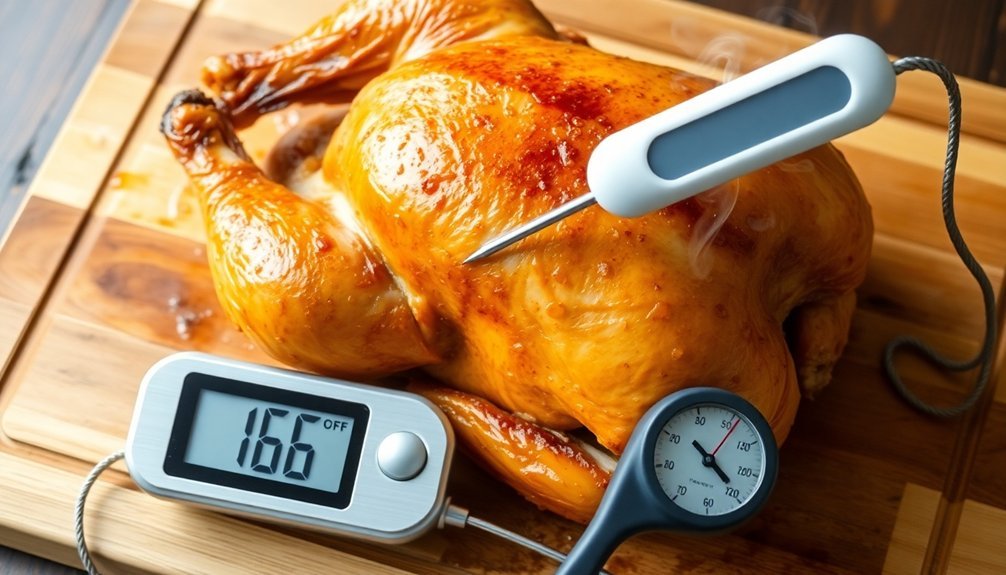
The relationship between temperature and holding time plays an essential role in achieving food-safe poultry.
You'll need to maintain specific temperatures for set durations to guarantee a 7-log 10 reduction in bacteria. While 165°F (74°C) provides instant safety, you can achieve the same results at lower temperatures with longer holding times.
For example, if you're cooking at 145°F (63°C), you'll need to maintain this temperature for 8.5 minutes. At 150°F (65.6°C), reduce the holding time to 3 minutes. When cooking at 155°F (68.3°C), hold for 49.5 seconds, and at 160°F (71.1°C), just 10 seconds will suffice.
Using a fast and accurate thermometer is essential for monitoring these precise temperature and time combinations. Remember that your oven's performance and the poultry's characteristics, including fat content and shape, will affect these calculations.
Post-Cooking Rest Periods
You'll need to let your cooked poultry rest for 10-15 minutes to achieve ideal temperature stabilization throughout the meat.
During this essential rest period, the internal temperature remains steady or slightly increases, ensuring any remaining bacteria are eliminated while the meat's juices redistribute evenly.
For smaller cuts like chicken breasts, you can reduce the rest time to 5-7 minutes, but always maintain proper food safety by keeping the meat covered and away from drafts.
Optimal Rest Duration Times
Properly resting your cooked chicken guarantees peak juiciness and flavor, with different methods offering varying durations of warmth retention.
While uncovered resting maintains crispy skin for up to an hour, tenting with foil extends warmth by 14 minutes, and wrapping tightly in foil and a tea towel keeps your bird warm for up to 100 minutes.
Choose your resting method based on your specific needs:
- Uncovered (59 minutes): Best for maintaining crispy skin while allowing adequate juice redistribution
- Tented with foil (73 minutes): Ideal balance between juice retention and skin texture
- Tightly wrapped (100 minutes): Perfect when you need extended time to prepare sides
- Quick rest (20-30 minutes): Suitable when time is limited but still secures basic juice redistribution
Room temperature and chicken size will affect these durations, so adjust accordingly.
Temperature Stabilization Benefits
When meat rests after cooking, temperature stabilization plays an essential role in both food safety and quality. During this vital period, heat distributes evenly throughout the meat, preventing the outer layers from overcooking while maintaining the ideal internal temperature.
You'll find that proper resting helps your poultry retain its moisture and tenderness, ensuring a consistent texture from edge to center. This process isn't just about improving taste – it's also important for food safety.
As your meat rests, it continues to combat harmful bacteria while staying above the danger zone temperature range of 40°F to 140°F.
This stabilization period gives you more flexibility in your cooking approach, allowing you to use various methods like slow cooking or sous vide while maintaining safe temperatures throughout the process.
Common Temperature Safety Mistakes
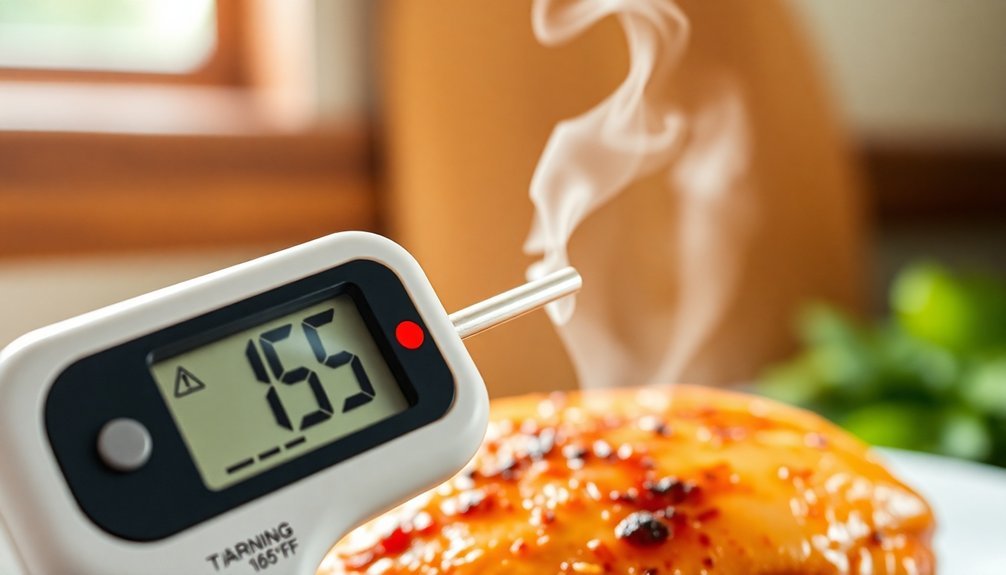
Despite widespread awareness about food safety, many home cooks still make significant temperature-related mistakes when preparing poultry. You'll need to avoid these common pitfalls to guarantee your chicken is both safe and delicious.
- Not using a thermometer to check internal temperature or placing it incorrectly in the thickest part of the breast
- Removing chicken too early without considering carryover cooking and resting time temperature increases
- Setting incorrect oven temperatures or failing to preheat properly before roasting
- Ignoring recommended safe temperatures of 165°F (74°C) and food safety guidelines for preventing cross-contamination
Understanding thermal gradients and temperature variations throughout your chicken is essential.
Don't rely on visual cues alone – different parts of the bird cook at different rates, and the outer portions will reach target temperature before the center does.
International Safety Standards
Food safety standards for poultry vary across different countries and regions, though most nations align closely with the widely accepted minimum temperature of 165°F (74°C).
You'll notice some differences when comparing guidelines – Health Canada recommends 180°F (82°C) for whole birds, while the USDA maintains 165°F (74°C) for all poultry products.
When you're following international guidelines, you'll find that most food safety organizations emphasize using a food thermometer to measure the internal temperature at the thickest part of the breast.
While there's slight variation in recommended temperatures, you should always guarantee proper resting time after cooking.
Scientific studies support these standards, particularly regarding Salmonella inactivation, with research showing that higher temperatures are especially important when cooking stuffed whole birds.
Solar Oven Temperature Monitoring
Monitoring temperature in a solar oven requires an extensive tracking system that combines real-time data collection with precise solar position calculations.
You'll need to integrate thermocouples and data loggers with mobile apps to track your oven's performance effectively.
For ideal temperature control in your solar oven, focus on these critical monitoring elements:
- Use silicon rubber gaskets to prevent heat loss while tracking temperature gradients across different zones
- Position reflectors strategically based on seasonal solar declination angles and real-time sun intensity
- Install a low-cost DC motor to maintain consistent heat as the sun moves
- Set up cloud-based platforms to store and analyze temperature data over time
The SAMPA algorithm and satellite-based systems like Solcast can help you achieve precise temperature control with highly localized data at 90-meter resolution.
Frequently Asked Questions
Can I Cook Different Types of Poultry Together at the Same Temperature?
You can cook different poultry together, but you'll need to monitor each piece separately with a food thermometer since they'll cook at different rates. Always guarantee each piece reaches its safe internal temperature.
Should I Adjust Cooking Temperature for Pre-Marinated or Brined Poultry?
No, you don't need to adjust the cooking temperature for marinated or brined poultry. Keep the same temperature and cooking time, but always guarantee it reaches 165°F internally for safe consumption.
Does Altitude Affect Recommended Oven Temperature for Cooking Poultry?
You don't need to adjust your oven temperature for cooking poultry at high altitudes. The recommended temperature stays the same, though you may need longer cooking times to reach the proper internal temperature.
How Does Convection Cooking Change the Recommended Temperature for Poultry?
When using convection cooking, you'll want to reduce your oven temperature by 25°F from standard recipes. The hot air circulation cooks food faster, so you'll still achieve the same results at a lower temperature.
Can I Safely Cook Frozen Poultry Without Thawing First?
Yes, you can safely cook frozen poultry without thawing. You'll need to increase cooking time by about 50% and guarantee it reaches 165°F internally. Just remember you can't use a slow cooker with frozen meat.
In Summary
You've now learned the key aspects of safe poultry cooking temperatures. Remember to maintain your oven at 350-450°F (175-230°C), always check internal temperatures reach 165°F (74°C), and use proper thermometer placement in the thickest part of the meat. Don't skip the resting period, and you'll avoid the common pitfalls of undercooked poultry. Whether using conventional or solar ovens, these guidelines guarantee your food safety.
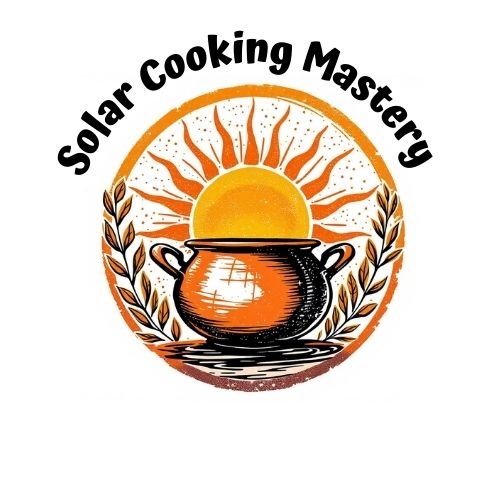

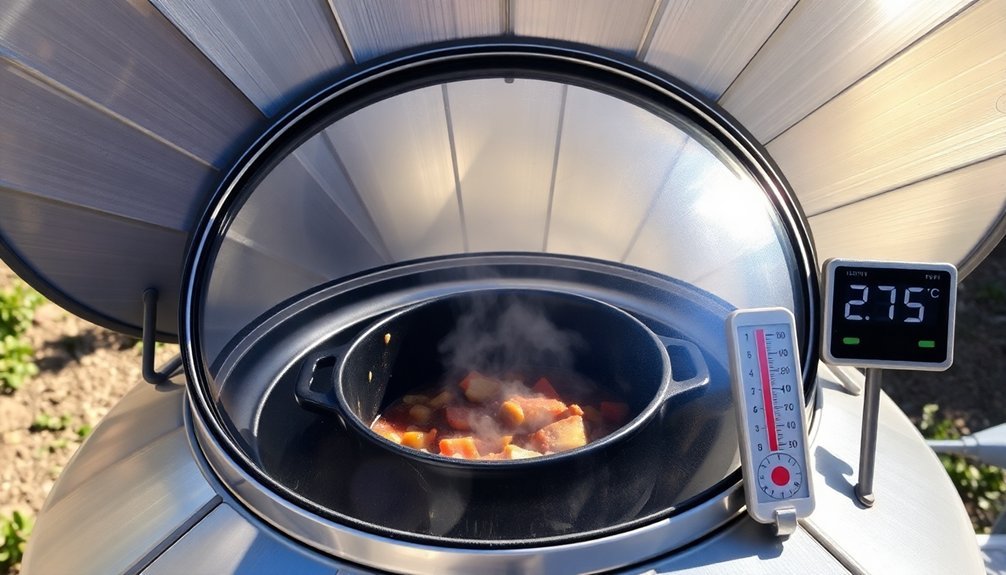


Leave a Reply